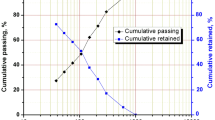Abstract
In this study, the effect of different process variables (pH, pulp density, and flocculant dosage) was investigated through statistical studies to know the individual and interactional effect on the responses of selective flocculation for low-grade iron fines using modified amphoteric starch as flocculant. For this study, a 3-level 3-factor (33) full factorial experimental design was adopted and experiments were carried out accordingly to obtain the optimum values and its effect on responses. The maximum recovery of 84.05% and highest grade of 65.54% were recorded using 10% pulp density, pH value of 10, and 1.5 mg/g flocculant dosage from feed grade of 56.54%.
Graphical Abstract









Similar content being viewed by others
References
Upadhyay RK, Venkatesh AS, Roy S (2010) Mineralogical characteristics of iron ores in Joda and Khondbond areas in Eastern India with implications on beneficiation. Resour Geol 60:203–211
Rao DS, Kumar TVV, Rao SS, Prabhakar S, Raju GB (2009) Mineralogy and geochemistry of a low grade iron ore sample from Bellary-Hospet Sector, India and their implications on benefication. J Miner Mater Character Eng 8:115–132
Nayak B, Sri D, Sharma M (2011) Mineralogical constraints on beneficiation of low-grade iron ores: case studies from Jharkhand and Goa, Proceedings of the XII International Seminar on Mineral Processing Technology,India, Oct 20–22
Ravishankar SA, Pradip DMG, Kulkarni RA, Gundiah S (1988) Selective flocculation of iron oxide-kaolin mixtures using a modified polyacrylamide flocculant. Bull Mater Sci 10:423–433
Upadhyay RK, Roy S, Venkatesh AS, Rao MVS, Banerjee PK (2009) Relevance of geological aspects and ore mineralogy in selecting beneficiation methods for processing of eastern Indian iron ores. Miner Process Extr Metall 118(1):49–59
Batisteli GMB, Peres AEC (2008) Residual amine in iron ore flotation. Miner Eng 21(12):873–876
Dworzanowski M (2012) Maximizing the recovery of iron ore using magnetic separation. J South Afr Inst Min Metall 112:197–202
Kumar R, Mandre NR (2016) Characterization and beneficiation of iron ore tailings by selective flocculation. Trans Indian Inst Met 69:1459–1466
Nanda D, Mandre NR (2018) Studies on characterization and beneficiation of typical low grade goethitic iron ore Jharkhand, India. Trans Indian Inst Met 71:2985–2992
Tudu K, Kumar S, Mandre NR (2018) Enhanced recovery of low grade iron ore by selective flocculation method. Dispers Sci Technol 39(8):1075–1079
Nanda D, Mandre NR (2019) Mechanism of polymeric adsorption in selective flocculation of low-grade Iron ore. Sep Sci Technol. https://doi.org/10.1080/01496395.2019.1708936
Beklioglu B, Arol AI (2004) Selective flocculation behavior of chromite and serpentine. Physicochem Probl Miner Process 38:103–112
Nanda D, Mandre NR (2022) Studies on performance evaluation of modified polymer on iron ore fines by selective flocculation process. J Sustain Metall 8:488–500
Weissenborn PK (1996) Behaviour of amylopectin and amylose components of starch in the selective flocculation of ultrafine iron ore. Int J Miner Process 47:197–211
Panda L, Banerjee PK, Biswal SK, Venugopal R, Mandre NR (2013) Performance evaluation for selectivity of the flocculant on hematite in selective flocculation. Int J Miner Metall Mater 20:1123
Ravishankar SA, Pradip KNK (1995) Selective flocculation of iron oxide from its synthetic mixtures with clays: a comparison of polyacrylic acid and starch polymers. Int J Miner Process 43:235–247
Weissenborn PK, Warren LJ, Dunn JG (1995) Selective flocculation of ultrafine iron ore 2. Mechanism of selective flocculation. Colloids Surf A: Physicochem Eng Asp 99:29–43
Orumwense FFO, Nwachukwu JC (2000) Flocculation studies on hematite-silica system using polymeric flocculants, Indian. J Chem Technol 7:23–29
Panda L, Biswal SK, Tathavadkar V (2010) Beneficiation of synthetic iron ore kaolinite mixture using selective flocculation. J Miner Mater Character Eng 9:973–983
Solarek et al. (1990) Amphoteric starches and process for their preparation.US4964953
Bindzus et al. (2002) Amphoteric starches used in papermaking.US6365002
Suc et al. (1995) Amphoteric starch containing carboxyl and cationic groups. US5417755
Chen G, Chen J, Li J, Guo SH, Srinivasakannan C, Peng JH (2012) Optimization of combined microwave pretreatment-magnetic separation parameters of ilmenite using response surface methodology. Powder Techno. https://doi.org/10.1016/j.powtec.2012.08.009
Chen G, Chen J, Srinivasakannan C, Peng JH (2012) Application of response surface methodology for optimization of the synthesis of synthetic rutile from titania slag. Appl Surf Sci 258(7):3073
Author information
Authors and Affiliations
Corresponding author
Ethics declarations
Conflict of interest
On behalf of all authors, the corresponding author states that there is no conflict of interest.
Additional information
The contributing editor for this article was Grace Ofori-Sarpong.
Publisher's Note
Springer Nature remains neutral with regard to jurisdictional claims in published maps and institutional affiliations.
Rights and permissions
Springer Nature or its licensor (e.g. a society or other partner) holds exclusive rights to this article under a publishing agreement with the author(s) or other rightsholder(s); author self-archiving of the accepted manuscript version of this article is solely governed by the terms of such publishing agreement and applicable law.
About this article
Cite this article
Nanda, D., Mandre, N.R. Performance Evaluation of Process Variables for Selective Flocculation of Iron Fines Using Modified Amphoteric Starch Through Full Factorial Statistical Analysis. J. Sustain. Metall. 9, 123–131 (2023). https://doi.org/10.1007/s40831-022-00630-9
Received:
Accepted:
Published:
Issue Date:
DOI: https://doi.org/10.1007/s40831-022-00630-9




